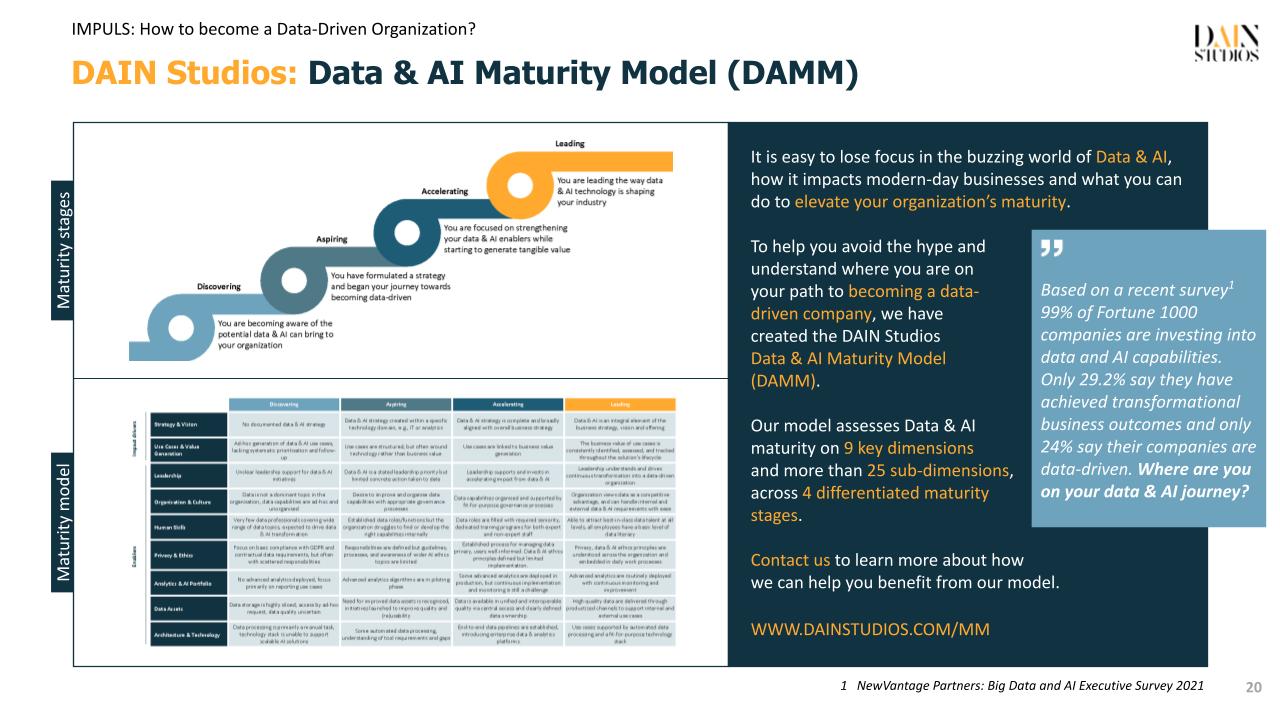Data has changed the landscape of business, offering a host of new opportunities. But why is it then that some firms are missing out on the advantages available?
Being a data-driven organization is not only tech people’s business – it’s businesses’ business. Every expert in every organization can become better at their job by using data and AI tools, leveraging the knowledge and experience of many, and calculating in ways our brains simply are not capable of.
How to become a data-driven organization is a question which has been asked many times in boardrooms around the world. In this article we’ll help you assess whether your company is maximizing its potential, examining strategies you can use to get more out of data and AI.
Before that let’s quickly illustrate the power of data by exploring the story of two farmers.
The power of data seen through the lens of two farmers
On the whole, food has become more abundant and cheaper in the 21st century even as the world’s population is growing fast. This is partly thanks to the use of data. To show how this is the case, let’s compare the story of two farmers. One lived in the 16th century, the other in the 21st.
Farmer number one lives in the 16th century. She makes her decisions about how to run her farm based on the experiences she has had in her own individual lifetime.
This contrasts with farmer number two who lives in the 21st century. Through the use of data, she has access to the life experiences of thousands of different farmers from across the world.
This wider range of insights about land, weather, and diseases puts her in a far stronger position to make the decisions that maximize productivity.
Data impact is borderless
It’s not just in agriculture that there are benefits. Data has generated efficiencies in every sector you can imagine. This includes logistics, services, and recruitment.
Here are the sorts of advantages on offer:
- For logistics systems data offers key benefits. These include the ability to get accurate inbound and outbound statistics. This is important because it helps firms monitor shipment frequencies, secure required capacity, and maintain optimum inventory levels.
- In the service industry, data has helped power AI systems that are leading the journey towards automation. Notable tools include predictive maintenance instruments which help firms raise efficiency.
- In recruitment, data has made a difference too. Here tools can be used to rank new candidates, evaluate employees, and track the efficiency of upskilling initiatives.
What’s stopping companies from becoming data driven?
A lack of awareness often holds back organizations. So, what are some of the common knowledge gaps?
- There is confusion about what AI actually is. When put on the spot to define AI, many business leaders are unsure. They might see AI as being just about revolutionary technology like self-driving cars rather than as a tool to improve everyday work and upgrade traditional business strategies.
- Once businesses understand what AI is and have gathered their data, it’s a matter of deciding on effective metrics. For people who are not well-versed in data, it can be difficult to determine the parameters that will open the opportunity for new insights to emerge.
- After the metrics are in place a subsequent challenge is interpretation and the actual gathering of insights. Because even if you have the right information organized in the correct way there can still be challenges when it comes to drawing conclusions.
- Finally, there can be problems putting insights into action. How, in other words, can you take all your hard work with data and AI and turn it into business value?
How can DAIN help your company get ahead?
Conscious of the difficulties many firms face with data and AI, at DAIN Studios we’ve
created a special framework called Data and AI Maturity Model (DAMM). It brings together all the elements you need to maximize the impact of data and AI on your business. The framework evaluates the impact drivers of your data transformation but also evaluates where you are standing on the necessary enablers for the impact drivers.
How does it work?
- During stage one we measure the data and AI capability of your organization
- Stage two is all about classifying your firm in our four-level table and understand on which maturity level your organization is
- The final stage, stage three, focuses on building the roadmap that’ll lead to results for your organization needed


